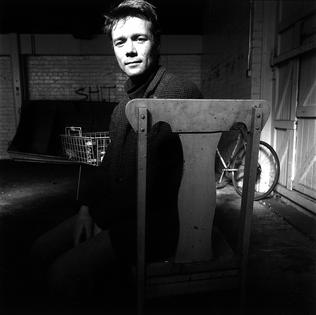
Arthur Merric Bloomfield Boyd was a leading Australian painter of the middle to late 20th century. Boyd's work ranges from impressionist renderings of Australian landscape to starkly expressionist figuration, and many canvases feature both. Several famous works set Biblical stories against the Australian landscape, such as The Expulsion (1947–48), now at the Art Gallery of New South Wales. Having a strong social conscience, Boyd's work deals with humanitarian issues and universal themes of love, loss and shame.

Joy St Clair Hester was an Australian artist. She was a member of the Angry Penguins movement and the Heide Circle who played an integral role in the development of Australian Modernism. Hester is best known for her bold and expressive ink drawings. Her work was charged with a heightened awareness of mortality due to the death of her father during her childhood, the threat of war, and her personal experience with Hodgkin's disease. Hester is most well known for the series Face, Sleep, and Love (1948–49) as well as the later works, The Lovers (1956–58).
Philippe Mora is a French Australian film director.
Charles Raymond Blackman was an Australian painter, noted for the Schoolgirl, Avonsleigh and Alice in Wonderland series of the 1950s. He was a member of the Antipodeans, a group of Melbourne painters that also included Arthur Boyd, David Boyd, John Brack, Robert Dickerson, John Perceval, and Clifton Pugh. He was married for 27 years to author, essayist, poet, librettist and patron of the arts Barbara Blackman.

The Antipodeans were a collective of Australian modern artists, known for their advocacy of figurative art and opposition to abstract expressionism. The group, which included seven painters from Melbourne and art historian Bernard Smith, was active in the late 1950s. Despite staging only a single exhibition in Melbourne in August 1959, the Antipodeans gained international recognition.
Asher Bilu is an Australian artist who creates paintings, sculptures and installations. He has also contributed to several films by Director Paul Cox as production designer. He was born in Israel, and began his career as an artist soon after arriving in Australia in 1956. From the start, his art has been abstract, with particular emphasis on technological experimentation. His technique changes as he investigates the use of new media, but his work always reflects his fascination with light, and his love of music and science, especially cosmology.

Sunday Reed was an Australian patron of the arts. Along with her husband, Reed established what is now the Heide Museum of Modern Art.

Mirka Madeleine Mora was a French-born Australian visual artist and cultural figure who contributed significantly to the development of Australian contemporary art. Her media included drawing, painting, sculpture and mosaic.
The Johnstone Gallery was a private gallery located in the suburb of Bowen Hills in Brisbane, Queensland, Australia co-owned by Brian Johnstone and his wife, Marjorie Johnstone. It was the leading Brisbane commercial gallery exhibiting contemporary Australian art from 1950 until 1972.

Gil Jamieson was an Australian painter. Jamieson was born in the central Queensland town of Monto in 1934 and died there in 1992.
Georges Mora was a German-born Australian entrepreneur, art dealer, patron, connoisseur and restaurateur.

Nora Sumberg is an Australian landscape painter whose work has over time become increasingly lyrical, abstract, and atmospheric. Her art is characterized by intense, floating swathes of colour, impressionistic and ambiguous terrain, and glowing, multi-directional light sources. Examples of Sumberg's art are held in The National Gallery of Victoria, The Queensland Art Gallery, The Heide Museum of Modern Art and the Smorgon Collection.

Pamela Mary Crawford was an Australian artist and stage designer married to the English-born Australian dramatist, James Crawford.
Piers Maxwell Dudley-Bateman was an Australian landscape painter. He was a member of The Antipodeans, a group of Melbourne painters that also included Arthur Boyd, David Boyd, Charles Blackman, John Brack, Robert Dickerson, John Perceval and Clifton Pugh. He taught as a Professor for painting at the Shanghai Institute of Visual Art under Fudan University in Shanghai, China.

David Larwill (1956–2011) was an Australian artist recognisable by his distinctive and exuberant style based on bold colour, stylised figures and simplified form. Although best known as a figurative expressionist painter, Larwill was also a draughtsman and printmaker of note. He produced many drawings, watercolours, ceramics and sculptures as well as etchings, lithographs and screenprints. In a career that stretched over 30 years, Larwill held over 25 solo exhibitions and participated in scores of group shows.
Kate Beynon is an Australian contemporary artist based in Melbourne.
The Museum of Modern Art Australia (MOMAA), alternatively named the 'Museum of Modern Art of Australia,' or, according to McCulloch, the 'Museum of Modern Art and Design' (MOMAD), was founded by Australian art patron John Reed in 1958 in Tavistock Place, a lane-way off 376 Flinders Street, Melbourne, launched previously with a survey of Modernist Victorian women artists on 1 June 1956, organised by the Reeds who had taken on the then named Gallery of Contemporary Art. It held exhibitions of important contemporary Australian and international art of the late 1950s and early 1960s. The Museum operated until 1966 and was formally dissolved in 1981.
Dawn Sime, who was also known as Dawn Frances Sloggett and Dawn Westbrook, was an abstract painter who was part of the expressionist movement in Melbourne in the late 1950s and 1960s. A pioneer of abstraction at the time, she was among only a few in the field She spent most of her life in Melbourne and died in Castlemaine.

Gray Smith was an Australian artist, poet and jeweller who was part of the Heide Circle. While best known as the famous Australian artist Joy Hester's spouse, his most productive artistic period came later while married to Joan Upward in the '60s and '70s. Smith's modernist paintings often featured isolated figures in Australian outback landscapes.
Rosemary Ryan was a mid to late twentieth-century Australian painter










